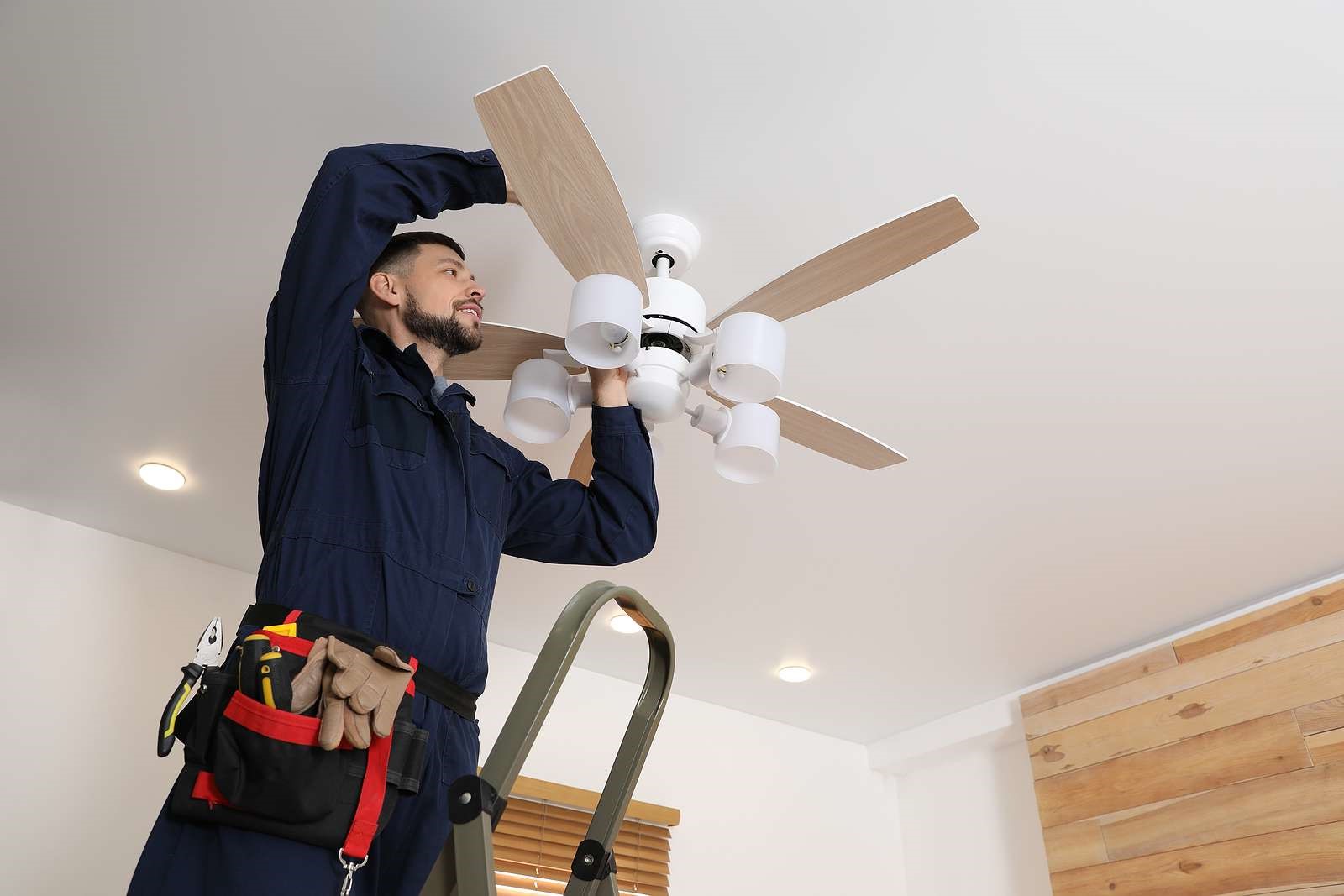Home>Home and Garden>How To Balance A Ceiling Fan


Home and Garden
How To Balance A Ceiling Fan
Published: March 4, 2024
Learn how to balance a ceiling fan with our step-by-step guide. Keep your home comfortable and stylish with our home and garden tips.
(Many of the links in this article redirect to a specific reviewed product. Your purchase of these products through affiliate links helps to generate commission for Noodls.com, at no extra cost. Learn more)
Table of Contents
Introduction
Balancing a ceiling fan is an essential maintenance task that can significantly improve its performance and extend its lifespan. Over time, ceiling fans can become unbalanced, leading to wobbling, noisy operation, and potential damage to the motor and other components. By addressing this issue, homeowners can ensure that their ceiling fan operates smoothly, quietly, and efficiently.
A balanced ceiling fan not only enhances the comfort of a room but also contributes to energy savings. When a fan is properly balanced, it can circulate air more effectively, helping to maintain a comfortable temperature and reduce the workload on heating and cooling systems. This can lead to lower energy consumption and reduced utility bills, making it a practical and cost-effective home improvement.
In addition to the functional benefits, a balanced ceiling fan also adds to the aesthetic appeal of a room. A fan that operates quietly and smoothly enhances the overall ambiance, allowing occupants to enjoy a peaceful and comfortable environment. Whether it's in a living room, bedroom, or any other space, a well-balanced ceiling fan can complement the decor and contribute to a more pleasant living experience.
In this comprehensive guide, we will walk you through the step-by-step process of balancing a ceiling fan. From turning off the fan and cleaning the blades to checking for loose screws and using a balancing kit, we will cover everything you need to know to restore your ceiling fan to optimal performance. By following these instructions, you can ensure that your ceiling fan operates efficiently, quietly, and safely, providing comfort and functionality for years to come.
Read more: How To Measure A Ceiling Fan
Step 1: Turn off the fan
Before beginning the process of balancing a ceiling fan, it is crucial to ensure the fan is completely turned off. This step is essential for safety and to prevent any accidental activation of the fan during maintenance. Here's how to safely turn off the fan and prepare for the balancing process:
-
Locate the Fan's Power Source: Identify the switch or pull chain that controls the ceiling fan. In most cases, the switch is located on the wall near the fan, while the pull chain is directly on the fan itself. Ensure that you have clear access to the switch or pull chain.
-
Turn Off the Power: If the fan is controlled by a wall switch, simply flip the switch to the "off" position. If the fan has a pull chain, gently pull the chain until the fan comes to a complete stop. It's important to wait for the fan blades to stop moving entirely before proceeding to the next steps.
-
Verify the Fan's Status: Once the fan has been turned off, visually confirm that the blades have come to a complete stop. This step is crucial for safety, as attempting to balance a fan with moving blades can be extremely dangerous.
-
Use Caution: When working near the fan, exercise caution to avoid accidentally turning it back on. If there are others in the vicinity, communicate that the fan is undergoing maintenance to prevent any accidental activation.
By following these steps to turn off the fan, you can ensure a safe and controlled environment for the subsequent tasks involved in balancing the ceiling fan. Safety should always be the top priority when performing maintenance on any electrical appliance, and this initial step sets the stage for a secure and effective balancing process.
Step 2: Clean the fan blades
Cleaning the fan blades is an essential step in the process of balancing a ceiling fan. Over time, dust, dirt, and other debris can accumulate on the blades, leading to an imbalance that affects the fan's performance. By thoroughly cleaning the blades, you can ensure that the fan operates more efficiently and smoothly, contributing to a quieter and more effective airflow.
To clean the fan blades, follow these steps:
-
Gather Cleaning Supplies: Before starting, gather the necessary supplies, including a sturdy stepladder, a microfiber cloth or duster, a vacuum cleaner with a brush attachment, and a mild cleaning solution. It's important to use a gentle cleaning solution to avoid damaging the fan blades.
-
Position the Stepladder: Place the stepladder directly beneath the ceiling fan, ensuring that it is stable and secure. Climbing the ladder with caution is crucial to prevent accidents or injuries.
-
Dust the Blades: Using a microfiber cloth or duster, carefully wipe down each fan blade to remove surface dust and debris. Start from the base of the blade and work your way towards the tip, ensuring that both the top and bottom surfaces are thoroughly cleaned. This initial dusting helps prepare the blades for a more detailed cleaning.
-
Vacuum the Blades: After removing the surface dust, use a vacuum cleaner with a brush attachment to further clean the fan blades. Gently run the brush attachment along the length of each blade, effectively removing any remaining dust and dirt. Pay close attention to the areas around the blade brackets and motor housing, as debris tends to accumulate in these areas.
-
Clean with a Mild Solution: If the fan blades require additional cleaning, prepare a mild solution of water and gentle dish soap. Dampen a clean cloth with the solution and carefully wipe down the blades, ensuring that excess moisture is avoided. It's important to be cautious with the amount of moisture applied to the blades to prevent any water from entering the motor housing or causing damage.
-
Dry the Blades: After cleaning with the mild solution, use a dry cloth to thoroughly dry the fan blades. Ensuring that the blades are completely dry before proceeding to the next steps is crucial to prevent any potential damage or operational issues.
By thoroughly cleaning the fan blades, you can remove accumulated dust and debris that contribute to imbalance and inefficient operation. This step sets the stage for the subsequent tasks involved in balancing the ceiling fan, ensuring that the fan operates at its best capacity.
Step 3: Check for loose screws or connections
After cleaning the fan blades, the next crucial step in balancing a ceiling fan is to inspect for loose screws or connections. Over time, the constant operation of the fan can cause vibrations that may loosen the screws holding the fan blades, motor housing, and other components in place. Additionally, electrical connections within the fan can become loose, impacting the overall stability and performance of the unit. By thoroughly checking for and addressing any loose screws or connections, you can ensure that the fan operates smoothly and safely.
Here's a detailed guide on how to check for loose screws or connections:
-
Secure the Power Source: Before proceeding with the inspection, ensure that the fan is turned off at the main power source. This precautionary measure is essential to prevent any accidental activation of the fan during the inspection process.
-
Visually Inspect the Fan: Begin by visually examining the fan for any visible signs of loose screws or connections. Check the blades, blade brackets, motor housing, and any other visible components for signs of movement or instability. Pay close attention to any areas where screws or fasteners are used to secure the fan's components.
-
Tighten the Screws: Using a screwdriver or appropriate tool, carefully tighten any loose screws found during the visual inspection. Start with the screws securing the blade brackets to the motor housing, as these are critical for maintaining the balance and stability of the fan blades. Additionally, check and tighten any screws or fasteners securing the motor housing to the ceiling mount.
-
Inspect Electrical Connections: Carefully examine the electrical connections within the fan, including those between the motor and the wiring harness. Ensure that all connections are secure and free from any signs of damage or wear. If any loose connections are identified, carefully reseat and secure them to prevent any potential electrical issues.
-
Test for Stability: Once all screws and connections have been inspected and tightened as needed, gently rock the fan to test its stability. Ensure that the fan does not wobble or exhibit any excessive movement. This test helps verify that the screws and connections have been properly secured, contributing to the overall stability of the fan.
By thoroughly checking for and addressing any loose screws or connections, you can enhance the stability and performance of the ceiling fan. This step is essential for ensuring that the fan operates quietly, smoothly, and safely, setting the stage for the subsequent balancing process.
Step 4: Use a balancing kit
Once the fan blades are clean and any loose screws or connections have been addressed, the next step in balancing a ceiling fan involves using a balancing kit. A balancing kit typically includes a balancing clip and a set of weights designed to counterbalance any uneven distribution of weight in the fan blades. By utilizing a balancing kit, homeowners can effectively fine-tune the balance of the fan, leading to smoother operation and reduced wobbling.
Here's a detailed guide on how to use a balancing kit to balance a ceiling fan:
-
Acquire a Balancing Kit: Obtain a ceiling fan balancing kit, which is readily available at hardware stores or home improvement centers. The kit typically includes a small clip and a set of self-adhesive weights designed for application to the fan blades.
-
Identify the Wobbling Blades: Turn the fan on to a low speed and observe the movement of the blades. Identify any blades that exhibit noticeable wobbling or uneven rotation. This visual inspection helps pinpoint the specific blades that require balancing.
-
Attach the Balancing Clip: Once the problematic blades have been identified, attach the balancing clip to the center of the top side of one of the blades. The clip serves as a temporary weight that helps determine the extent of imbalance in the blade.
-
Observe the Fan's Behavior: Turn the fan on to a low speed and observe whether the wobbling or imbalance has been reduced with the addition of the balancing clip. If the wobbling persists, consider repositioning the clip to different blades to identify the most effective placement.
-
Apply Self-Adhesive Weights: Once the optimal placement of the balancing clip has been determined, remove the clip and clean the area where it was attached. Then, apply the self-adhesive weights to the top side of the blade in the same location where the clip was previously positioned. The weights should be applied incrementally, allowing for careful observation of the fan's behavior after each application.
-
Test the Fan: After applying the self-adhesive weights, turn the fan on to a low speed and observe its behavior. The goal is to achieve a significant reduction in wobbling and uneven rotation. If necessary, make further adjustments to the placement and quantity of the weights until the fan operates smoothly and quietly.
By using a balancing kit to fine-tune the balance of the fan blades, homeowners can effectively mitigate wobbling and ensure that the fan operates at its optimal capacity. This step is crucial for achieving a quiet and stable operation, contributing to a more comfortable and enjoyable living environment.
Read more: How To Clean Popcorn Ceiling
Step 5: Test the fan
After completing the previous steps of turning off the fan, cleaning the blades, checking for loose screws or connections, and using a balancing kit, the final crucial step in balancing a ceiling fan is to thoroughly test its performance. Testing the fan allows homeowners to assess the effectiveness of the balancing efforts and ensure that the fan operates smoothly, quietly, and efficiently.
Here's a detailed guide on how to test the fan after the balancing process:
-
Turn On the Fan: Once the balancing process is complete, turn the fan on to a low speed setting. Observe the initial behavior of the fan to determine if there is any noticeable wobbling or uneven rotation. This initial test provides valuable insight into the impact of the balancing efforts.
-
Gradually Increase Speed: After confirming that the fan operates smoothly at a low speed, gradually increase the speed to higher settings. Observe the fan closely at each speed level to ensure that the wobbling has been effectively mitigated and that the fan operates quietly and efficiently.
-
Listen for Noise: While the fan is running at various speeds, listen for any unusual noises or vibrations. A well-balanced fan should operate quietly, without producing excessive noise or rattling. Any unexpected sounds may indicate that further adjustments are needed to achieve optimal balance.
-
Verify Stability: Gently rock the fan from side to side and observe its stability. A properly balanced fan should remain steady and level, without exhibiting any excessive movement or wobbling. This test helps confirm that the fan is securely mounted and that the balancing efforts have been successful.
-
Observe Airflow: As the fan operates at different speeds, pay attention to the airflow it generates. A balanced fan should effectively circulate air throughout the room, contributing to a comfortable and consistent airflow pattern. Verify that the fan's airflow is uniform and does not cause any drafts or disturbances.
-
Make Further Adjustments if Necessary: If any wobbling, noise, or instability is observed during the testing phase, consider making further adjustments to the fan's balance. This may involve repositioning the balancing weights or addressing any remaining issues with the fan's components.
By thoroughly testing the fan after the balancing process, homeowners can ensure that the fan operates at its optimal capacity, providing quiet, efficient, and reliable performance. This final step is essential for confirming the success of the balancing efforts and ensuring a comfortable and enjoyable living environment.
Conclusion
Balancing a ceiling fan is a fundamental maintenance task that not only enhances the fan's performance but also contributes to the overall comfort and energy efficiency of a living space. By following the step-by-step process outlined in this guide, homeowners can effectively restore their ceiling fan to optimal operation, ensuring smooth, quiet, and efficient airflow.
The process begins with the essential step of turning off the fan to create a safe environment for maintenance. Cleaning the fan blades is then crucial to remove accumulated dust and debris that can contribute to imbalance and inefficient operation. Checking for loose screws or connections is another critical step, as it ensures the stability and safety of the fan's components.
The use of a balancing kit allows homeowners to fine-tune the balance of the fan blades, mitigating wobbling and ensuring smooth and quiet operation. Finally, thorough testing of the fan's performance confirms the success of the balancing efforts and ensures that the fan operates at its optimal capacity.
A well-balanced ceiling fan not only provides a comfortable and consistent airflow but also contributes to energy savings by reducing the workload on heating and cooling systems. This can lead to lower energy consumption and reduced utility bills, making it a practical and cost-effective home improvement.
In addition to the functional benefits, a balanced ceiling fan enhances the aesthetic appeal of a room, contributing to a peaceful and comfortable environment. Whether in a living room, bedroom, or any other space, a well-balanced ceiling fan complements the decor and adds to the overall ambiance.
By prioritizing the maintenance and balance of a ceiling fan, homeowners can ensure long-term reliability and performance, creating a more comfortable and enjoyable living environment. Regularly incorporating these maintenance steps can help extend the lifespan of the fan and maximize its energy-saving potential, making it a valuable investment for any home.
In conclusion, the process of balancing a ceiling fan is a simple yet impactful way to enhance comfort, energy efficiency, and the overall ambiance of a living space. By following the steps outlined in this guide, homeowners can effectively maintain and optimize the performance of their ceiling fan, contributing to a more enjoyable and cost-effective living experience.














